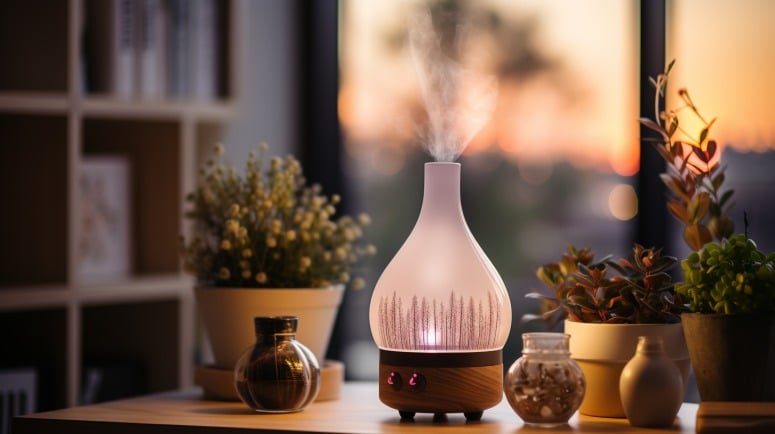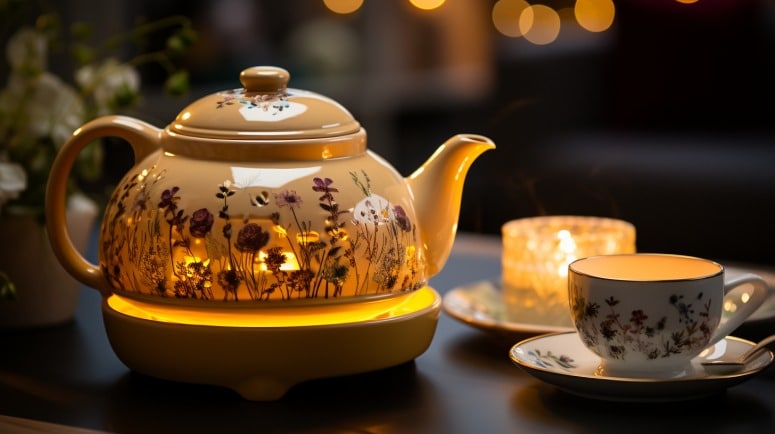Tea time in England encapsulates the rich history and essence of British society, offering a delightful interlude where hot tea, finger sandwiches, and sweet treats unite. With diverse variations such as afternoon tea, high tea, and elevenses, the British tea culture has solidified its place in daily life throughout the centuries. Embrace the serenity of sipping a perfectly steeped cup and join us on a journey exploring the fascinating world of tea time in England.

Table of Contents
A Sip of History: The Origins of Tea Time in England
The journey of tea time in England began with the arrival of tea from China in the 17th century. As tea consumption increased, by the mid-18th century, it overtook other beverages in popularity. However, the tea time tradition we recognize today was born in the 19th century when Anna Maria Russell, the Duchess of Bedford, introduced a daily afternoon tea ritual. Tired of hunger pangs caused by long hours between lunch and supper, the Duchess invited her friends to join her for light snacks and a cup of tea in the afternoon.
This innovative idea quickly gained traction among the British upper class, transforming tea time into a sophisticated social event. Over time, the tea time custom expanded to different variations, such as afternoon tea and high tea, catering to diverse social classes and lifestyles. Tea time has thus come to encapsulate the essence of British culture and its rich historical traditions.

The Art of Tea Time: Exploring the Many Forms of British Tea Time
In the world of British tea time, there is remarkable variety in the different ways one can enjoy this cherished tradition. While some forms of tea time are now famous worldwide, others remain lesser-known gems. Let’s delve into the delightful variety of British tea time, from the refined elegance of afternoon tea to the hearty satisfaction of high tea.
Afternoon Tea: An elegant tradition occurring between 3 pm and 5 pm, offering finger sandwiches, bread, scones, and pastries with a pot of hot tea.
High Tea: Historically catered to the working class, this evening meal features hearty food, including meat pies, cold cuts, and baked goods.
Cream Tea: A simplified tea time focused on scones served with clotted cream and jam, accompanied by a pot of hot tea.
Elevenses: A casual late morning break, usually consisting of tea and light snacks, such as biscuits or pastries.
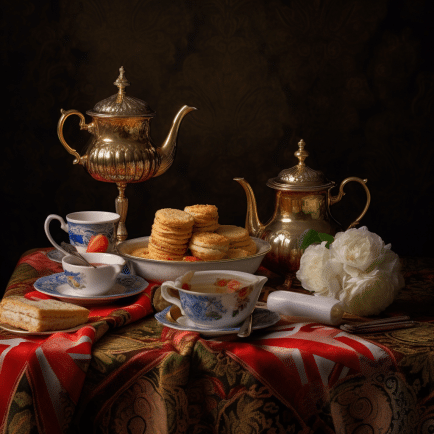
Minding Your Manners: Tea Time Etiquette and Customs to Know
British tea culture is steeped in tradition and etiquette, and mastering the art of tea time is as much about savoring the delicious snacks as it is about adhering to age-old customs. By understanding some essential tea time etiquette, you can enhance your enjoyment of this quintessentially British experience.
The Perfect Brew: Use loose-leaf tea and steep according to its specific type, with milk added after the tea is poured into the cup.
The Art of Stirring: Gently stir using a back-and-forth motion to avoid clinking and spills.
Serving the Tea: Ensure every guest has a cup before pouring and offer milk, sugar, and lemon slices on the side.
Tea Time Conversation: Engage in polite, light-hearted small-talk, avoiding controversial or personal topics.
Mind Your Table Manners: Eat finger sandwiches and pastries in small bites and apply cream and jam to scones piece by piece.
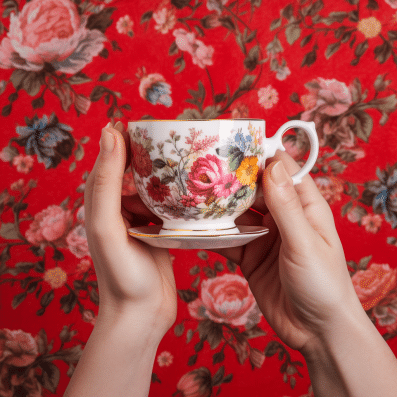
A Taste of Britain: Decoding the Delights of Tea Time Treats
Tea time in England is a delightful medley of irresistible flavors, textures, and aromas. From savory sandwiches to sweet scones and delectable pastries, British tea time offers a little something for everyone. Let’s take a closer look at some of the mouthwatering treats that epitomize the joys of tea time.
Finger Sandwiches
An afternoon snack or tea classic, finger sandwiches are as dainty as they are delicious. Traditional options include cucumber sandwiches, smoked salmon with cream cheese, egg and cress, and coronation chicken. Whichever variety you choose, the delicate size of finger sandwiches allows for ample sampling.
Scones
Scones hold a special place in British hearts and tea tables alike. Slightly crumbly and mildly sweet, they’re the perfect vehicle for indulgent clotted cream and fruit jams. Whether you’re a fan of plain, fruit-filled, or flavored scones, they are an indispensable part of tea time.
Cakes and Pastries
A tea time spread wouldn’t be complete without an array of cakes and pastries. Some quintessential favorites include Victoria sponge cake, fruit tarts, macarons, and éclairs – all designed to satisfy any sweet tooth.
Biscuits and Tarts
Biscuits and tarts provide yet another layer of temptation to the tea table. Classics like shortbread and custard creams are perfect for dunking and savoring, while Tarte Tatin and Bakewell tarts bring a touch of sophistication.
Tea
Of course, no tea time would be complete without the star of the show – tea! A variety of tea options are usually on offer to suit every taste, from traditional Earl Grey and English Breakfast to more floral and fruity blends. So, go ahead and sip, savor, and enjoy the warm embrace of a perfectly brewed cup of tea. With such a delectable array of treats, British tea time is an opportunity to indulge in the finest flavors and textures the culinary world has to offer.
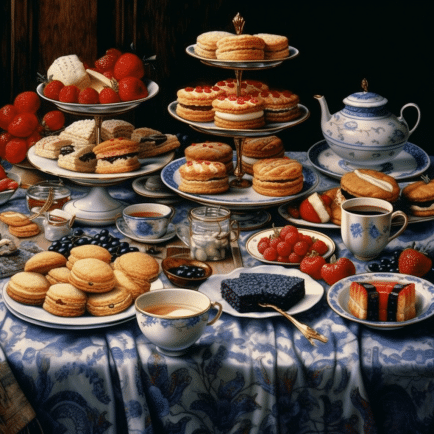
Tea Time for the Modern Tastemaker: The Contemporary Tea Experience
The traditions of tea time have evolved to cater to modern tastes and lifestyles. Themed tea parties inspired by pop culture, culinary twists on classic tea treats, and vegan or gluten-free menu options cater to diverse experiences. Additionally, grab-and-go tea-time options such as portable scones and sandwiches allow busy individuals to enjoy tea time on their terms.
Exploring the Charm of England’s Tea Time Destinations
Experiencing tea time in England transcends more than just the snacks and beverages. Some of the most iconic tea time destinations offer a blend of exquisite ambiance, rich history, and unparalleled service. Some must-visit stops for tea enthusiasts traveling to England include:
The Ritz London: A legendary venue, The Ritz offers one of the most grand and opulent afternoon snack and tea experiences.
Sketch, London: This quirky establishment serves an eclectic and modern take on mid afternoon tea in a fantastical art-filled environment.
The Pump Room, Bath: In the historic city of Bath, tea aficionados can sip their favorite brew in the grandeur of the Georgian era.
Betty’s Tea Room, Harrogate: This charming spot offers a quaint and cozy setting where patrons can indulge in an array of tea time treats.
No matter where you choose to enjoy your tea time in England, the delightful combination of serene ambiance, scrumptious treats, and refreshing brews creates an unforgettable experience for all who partake.
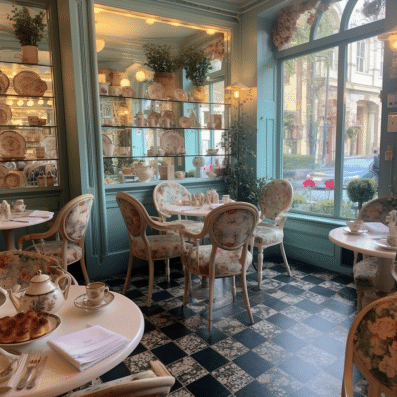
Steeping in Tradition: A Look Back at England’s Tea Time Journey
Through our exploration of the diverse world of tea time in England, we’ve seen how this cherished tradition like a special occasion, spans the social ladder, from the upper class indulgence of afternoon tea to the hearty sustenance of meat tea for the lower classes. Steeped in social history and reflecting distinctions between social classes, English tea times have evolved into a delightful tapestry of experiences, from the very casual affair of elevenses to the exquisite sophistication of five o’clock tea parties.
The assortment of English tea times, such as morning tea – perhaps enjoyed as a second breakfast – and Devonshire tea, with its rich, sumptuous scones, all bring people together. Furthermore, as an institution in English society, tea etiquette remains crucial, regardless of whether you are having high tea (traditionally referred to as the main evening meal) or low tea, served in low armchairs with tea cups and a tea pot.
Cakes or pastries, light or strong tea, and the customary bustle of conversation are all essential aspects of the tea time experience. From tea breaks at the workplace to the social ritual of five o’clock tea, these moments punctuate daily life and provide opportunities for connection. In conclusion, the history and breadth of England’s tea time traditions offer a fascinating glimpse into this nation’s social evolution.
Driven by social class and reflective of the customs of each era, tea time has remained a beloved practice for Brits of all walks of life. No matter the setting, the enjoyment of a warm cup of tea and delicious accompaniments is a testament to the resilience and appeal of this uniquely English experience.
What is the difference between afternoon tea and high tea?
Afternoon tea is a refined, elegant affair usually enjoyed between 3 pm and 5 pm. It consists of finger sandwiches, scones with clotted cream and jam, cakes, pastries, and hot tea. It is often associated with the upper class and can be found in luxurious hotels, teahouses, or private homes. High tea, on the other hand, historically catered to the working class as an evening meal between 5 pm and 7 pm. It features hearty foods like meat pies, cold cuts, baked goods, and robust sandwiches. It traditionally takes place at a dining table, unlike the low-sitting afternoon tea.
What is the proper way to prepare and serve tea during tea time?
To prepare the perfect cup of tea, use loose-leaf tea and steep it for the recommended time based on the type of tea (3-5 minutes for black tea, 2-3 minutes for green tea). Milk is usually added after the tea is poured into the cup. When hosting a tea party, be sure to offer milk, sugar, or lemon slices to accommodate personal preferences. Pour the tea gracefully, ensuring each guest has their cup and saucer before serving the tea.
What are the essential elements of tea time etiquette?
Essential aspects of tea time etiquette include using proper techniques for stirring tea (gently moving the spoon back and forth), engaging in polite conversation, and practicing good table manners such as taking small bites and breaking scones into manageable pieces. It’s important to show respect for the traditions surrounding tea time and adhere to proper customs when hosting or attending tea time events.
How has tea time evolved in modern times?
While the classic tea time experience is still cherished, modern tea time has evolved to cater to contemporary tastes and diverse preferences. Themed tea parties, innovative twists on traditional treats, and options like vegan or gluten-free menus are now common. Furthermore, grab-and-go tea time options have gained popularity, allowing busy individuals to enjoy their tea time on their terms, whether on a park bench or at their desk at work. The modern tea experience offers a range of options, from whimsical to luxurious to offbeat, for everyone to enjoy and savor the British tea time tradition.

